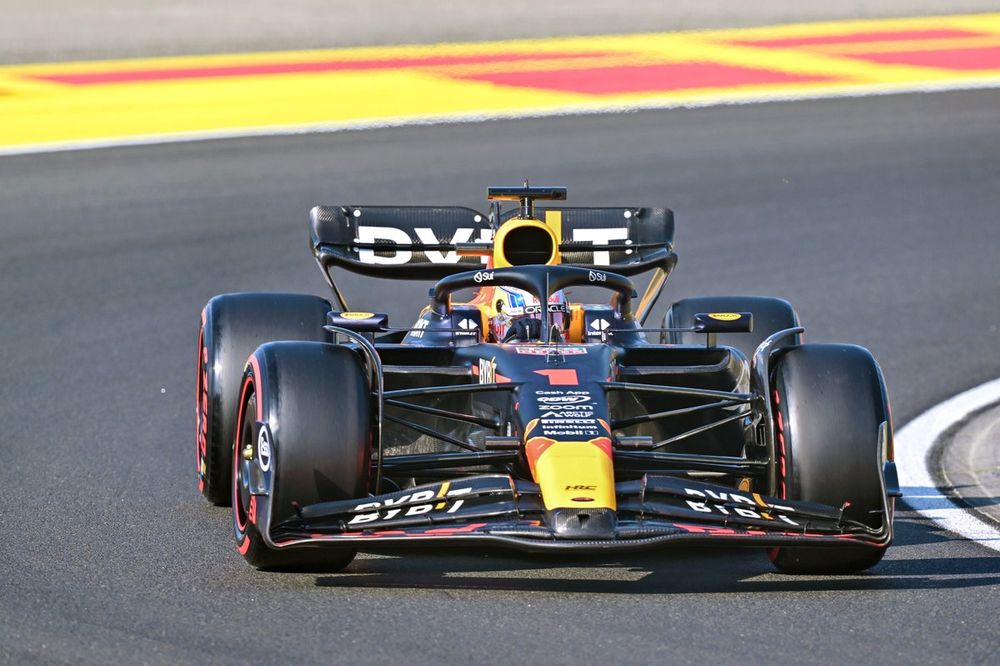
As a result, the Red Bull F1 driver crossed the timing line in Q3 with seven seconds left to run but having circulated 0.02s slower than his previous effort.
That left the door open for Lewis Hamilton. In a shootout where track evolution was pronounced, he was the last person over the line and bolted to a 1m16.609s. That returned his 104th pole position and prevented Verstappen from snaring a sixth in a row. The Mercedes racer had hustled the W14 round the 2.72-mile Budapest lap 0.023s quicker than Verstappen’s final lap and 0.003s better than his rival's best.
Where Hamilton pulled ahead of Verstappen
Verstappen bemoaned the Alternative Tyre Allocation experiment come the end of Friday practice. He reckoned the mileage-limiting, tyre-saving incentive had left Red Bull to not fully understand its extensive upgrade, the RB19 having gained revised sidepod inlets, engine cover, floor edge and front and rear brake ducts. Exacerbated by wet weather disrupting FP1, he had been unable to find the balance sweet spot.
The GPS data from Verstappen’s best lap in Q3 - a 1m16.612s set with seven minutes remaining - gives him the slight edge over Hamilton into Turn 1. The RB19 carries an extra 1.25mph before hitting the anchors, although there’s virtually nothing to split the duo on the brakes. At the apex, Hamilton runs 2.5mph faster although that’s not enough to keep pace with Verstappen, who holds a 0.043s delta at the mid-point of the right-hander.
But this slender advantage is short-lived. Verstappen has a minor correction and lift. Once he's reapplied the throttle, it's enough to drop him 0.117s behind the Mercedes. Hamilton is able to hold that cushion for the run into Turn 2, but Verstappen fights back and transforms it into a 0.051s lead by running 5mph quicker on entry. Again, however, he suffers under power as Hamilton uses the shorter straight to move back in front by 0.04s.
To the exit of Turn 5, the medium-speed right at the bottom of the circuit, there's little to split the pair. But then Verstappen’s lap begins to fall apart. He loses some 0.178s through the chicane. The onboard camera reveals little - perhaps Verstappen is a little conservative at the change of direction. But there’s no major moment.

The GPS data makes it look a little more dramatic. Hamilton is close to 9mph faster on entry and choses to downshift another gear to third. Verstappen holds it in fourth, but his revs drop out of the power band. This might also encourage a little more understeer. Either way, it results in the reigning two-time champion falling behind Hamilton for the rest of the lap.
Hamilton’s aggression on entry tallies with Mercedes motorsport boss Toto Wolff saying his driver finally had confidence in the car heading into Q3.
Verstappen shaves 0.04s off through to Turn 12 and then more decisively brings the gap down to 0.058s by hitting a higher top speed on the back straight before shedding it more quickly than Hamilton under braking. The RB19 steps out again under power and Verstappen is made to pay for losing 15mph relative to Hamilton during the short burst of acceleration into the final corner.
The gap bleeds out to 0.215s before Verstappen masters Turn 13 and the rebadged Honda engine stretches its legs to the line to bring Hamilton’s advantage down to 0.003s.
Why Verstappen failed to improve in Q3

Given Verstappen’s messy Turn 1 exit during his first attempt in Q3, his second go is more convincing. He recovers the small 0.04s deficit that came from hitting a lower top speed at the end of the main straight. His apex of Turn 2 isn’t as strong, however, and this means he’s 1.5mph slower down the hill to Turn 4. It’s marginal, but his first sector is 0.042s worse off.
Verstappen quickly sets this straight and is 0.09s better off through Turn 5. While he again tries the chicane in fourth gear, a tidier run means his second lap is now 0.15s quicker. He keeps improving in the second sector through the more open Turns 9-11 to better his personal best by 0.239s.
However, he undoes that hard work through the final two corners. He’s quicker to come off the throttle this time and that means he is 5mph slower into the apex of the penultimate left-hander. That brings his second Q3 lap advantage down to 0.105s. Verstappen is then much later picking up the throttle out of the last corner and so his final sector is 0.217s adrift.
The lap time Verstappen was actually capable of
Neither Verstappen nor Hamilton achieved their theoretical fastest lap in Q3. It was left to McLaren driver Lando Norris, who qualified in third place courtesy of a 1m16.694s, to stitch together his three fastest sectors at the death. Hamilton, meanwhile, might have found another 0.039s had he matched his time through the final sector from his first Q3 lap.
Verstappen, however, was far more wasteful. Had he repeated his earlier times through the first and final sectors when it came to his second flying lap and added that to his 27.044s dash through the middle part of the lap, the clock would have stopped at 1m16.373s.
In other words, the Red Bull driver might have been 0.197s better than a perfect lap from Hamilton and potentially 0.236s ahead of what the Mercedes driver actually delivered when it counted.







